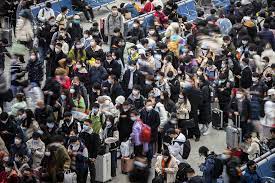The Biden administration announced on Wednesday that travelers from China, Hong Kong and Macau must present negative Covid-19 tests before entering the United States, a move that it says is intended to slow the spread of the coronavirus. The requirement will take effect on Jan. 5.
The announcement, by the Centers for Disease Control and Prevention, came amid growing concern over a surge of cases in China and the country’s lack of transparency about the outbreak there.
C.D.C. officials said the requirement for testing will apply to air passengers regardless of their nationality and vaccination status. It will also apply to travelers coming from China who enter the United States through a third country, and to those who connect through the United States to other destinations. Italy and Japan have already imposed similar restrictions.
But as they did when President Donald J. Trump imposed pandemic travel limitations, some experts questioned whether the testing requirement would do any good — especially given the surge in cases in the northeastern United States. The American trend is being fueled by an especially fast-spreading Omicron subvariant: XBB, which appears to be spreading more quickly than ones related to the dominant variant in Beijing.
“I understand politically why it must be done, but the bottom line is, it’s a false sense of security that we’re really slowing transmission,” said Michael T. Osterholm, the director of the Center for Infectious Disease Research and Policy at the University of Minnesota.
China’s Covid outbreak has been worsening in recent days, with local governments reporting hundreds of thousands of infections a day. Videos obtained by The New York Times show sick patients crowding hospital hallways. But the situation is difficult to track in real time because China does not release reliable Covid data.
After three years of insisting on a “zero Covid” policy, China made an abrupt turnabout in early December and lifted that policy, after mass protests over lockdowns that threatened the ruling Communist Party. Since then, there has been an explosion of cases in Beijing.
Scientists in Hong Kong have reported that an Omicron subvariant known as BF.7 has been responsible for the Beijing outbreak. That variant is a sublineage of BA.5, which has until recently been dominant in the United States. But BF.7, while present in the United States for months, has not shown signs of outcompeting other versions of Omicron here.
The C.D.C. estimated that BF.7 made up 4 percent of cases in late December, and that it had become less common since November. Other Omicron subvariants that scientists believe may be more adept at evading existing immune responses, including XBB, are currently more prevalent in the United States.
Scientists said that, for now at least, the variant that fuels China’s outbreak may not necessarily be the one that most effectively sidesteps immune responses. Because so few people in China have been infected with versions of Omicron, any of the highly contagious Omicron subvariants that have been circling the world lately could take off there.
In a population like China’s with so little existing immunity from infections, the dominant variant may not necessarily be the one that is best at getting around those immune responses, but simply the one that happens to catch fire, they said.
“In some sense, whatever took off first is probably going to be dominant there,” said James Wood, an infectious disease expert at the University of New South Wales in Sydney.
In the United States, the C.D.C. estimated last week that the XBB subvariant has grown to account for nearly a fifth of cases in the country, up from only 3 percent of cases a month earlier.
XBB is spreading especially quickly across the northeast United States, scientists have said, accounting for more than half of new infections there. And it appears to have an advantage over the BQ.1 Omicron subvariants that have lately been dominant in the United States, scientists said.
Scientists are in the early stages of studying the XBB subvariant. They said that an even newer version of that subvariant had emerged, known as XBB.1.5. Preliminary studies have suggested that that latest version of XBB is adept at evading existing immune responses and at binding to human cells.
THE NEW YORK TIMES

Leave a Reply
You must be logged in to post a comment.